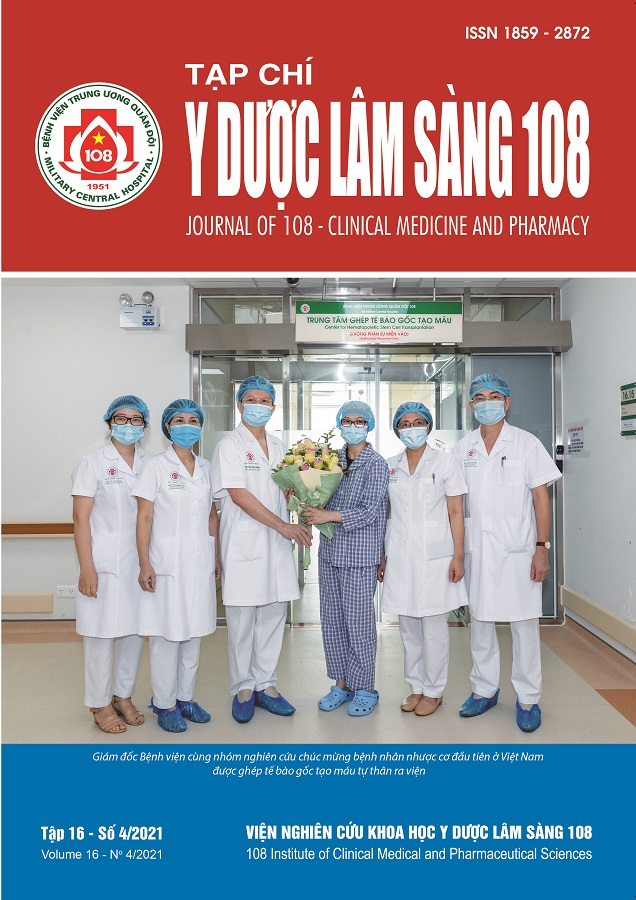Nút động mạch tuyến tiền liệt điều trị tăng sinh lành tính tuyến tiền liệt: Kết quả điều trị sau 6 tháng và 12 tháng
Main Article Content
Keywords
Tóm tắt
Mục tiêu: Đánh giá kết quả điều trị tăng sinh lành tính tuyến tiền liệt bằng kỹ thuật nút động mạch tuyến tiền liệt sau 6 tháng và 12 tháng. Đối tượng và phương pháp: Nghiên cứu can thiệp lâm sàng trên 66 bệnh nhân tăng sinh lành tính tuyến tiền liệt được điều trị nút động mạch tuyến tiền liệt tại Bệnh viện Hữu nghị từ tháng 05/2015 đến tháng 06/2019, đánh giá kết quả điều trị dựa trên thay đổi điểm số IPSS và QoL cũng như đáp ứng lâm sàng sau can thiệp 6 tháng và 12 tháng. Kết quả: Chỉ số IPSS trung bình trước nút mạch 30,8 ± 2,36, sau nút mạch 6 tháng giảm 17,3 ± 2,5 điểm tương đương 56,2 ± 6,83%, sau 12 tháng giảm 15,3 ± 3,63 điểm tương đương 49,6 ± 10,99%. QoL trung bình trước nút mạch là 4,7 ± 0,46, giảm 2,08 ± 0,73 điểm sau can thiệp 6 tháng và giảm 1,77 ± 0,65 sau can thiệp 12 tháng. Tỉ lệ đáp ứng lâm sàng 6 tháng sau can thiệp là 89,4%, 12 tháng sau can thiệp là 80,3%. Các yếu tố ảnh hưởng tích cực tới khả năng duy trì đáp ứng lâm sàng sau 12 tháng gồm: Tuyến tiền liệt không lồi vào lòng bàng quang, thể tích tuyến < 80mL, BN được nút tắc động mạch tuyến tiền liệt ở cả hai bên. Kết luận: Nút động mạch tuyến tiền liệt là phương pháp điều trị hiệu quả, giúp cải thiện triệu chứng và chất lượng cuộc sống cho bệnh nhân tăng sinh lành tính tuyến tiền liệt, hiệu quả điều trị được duy trì tới 12 tháng
Article Details
Các tài liệu tham khảo
2. Pisco JM et al (2016) Medium and long-term outcome of prostate artery embolization for patients with benign prostatic hyperplasia: Results in 630 patients. J Vasc Interv Radiol 27(8): 1115-1122.
3. Kuang M, Vu A, and Athreya S, Systematic A (2017) Review of prostatic artery embolization in the treatment of symptomatic benign prostatic hyperplasia. Cardiovasc Intervent Radiol 40(5): 655-663.
4. Ray AF et al (2018) Efficacy and safety of prostate artery embolization for benign prostatic hyperplasia: An observational study and propensity-matched comparison with transurethral resection of the prostate (the UK-ROPE study). BJU Int 122(2): 270-282.
5. Bilhim T et al (2016) Predictors of clinical outcome after prostate artery embolization with spherical and nonspherical polyvinyl alcohol particles in patients with benign prostatic hyperplasia. Radiology 281(1): 289-300.
6. Carnevale FC et al (2020) Prostatic artery embolization for the treatment of lower urinary tract symptoms due to benign prostatic hyperplasia: 10 years' experience. Radiology 296(2): 444-451.
7. Maclean D et al (2018) Factors predicting a good symptomatic outcome after prostate artery embolisation (pae). Cardiovasc Intervent Radiol 41(8): 1152-1159.
8. Yu SCH et al (2019) Thickness-to-Height ratio of intravesical prostatic protrusion predicts the clinical outcome and morbidity of prostatic artery embolization for benign prostatic hyperplasia. J Vasc Interv Radiol 30(11): 1807-1816.
9. Carnevale FC et al (2017) Recurrence of lower urinary tract symptoms following prostate artery embolization for benign hyperplasia: single center experience comparing two techniques. Cardiovasc Intervent Radiol 40(3): 366-374.
10. Hacking N et al (2019) Technical and imaging outcomes from the uk registry of prostate artery embolization (uk-rope) study: Focusing on predictors of clinical success. Cardiovasc Intervent Radiol 42(5): 666-676.
 ISSN: 1859 - 2872
ISSN: 1859 - 2872
